When planning a supply chain from a logistics perspective, it is often useful to conduct a little thought experiment and think of yourself in the position of the products involved. In order to do this, you should “be the box” and trace each step you take from the factory to your customer, how much time you need to arrive and all of the steps you need to go through to get there. Let’s say you are a product, a piece of machinery made in a factory in Pennsylvania, United States. Post-production, you need to be packaged a certain way and the relevant paperwork prepared for export and import to the client’s destination, e.g., Germany. For this purpose, export and import documentation need to be prepared, product specification sheets, customs declaration forms, etc. Before “leaving” the factory you need to be packaged and the documentation needs to be prepared and added to the packaging. You are then picked up by a courier, who potentially needs a copy of certain documentation, and brought to a storage/sorting facility. You need to be marked clearly beforehand or afterwards in order to insure you are not confused with another piece of machinery. Then when ordered by a client, you may need to be re-packaged, for which the necessary documentation needs to be available to the courier before being shipped out. You are then picked up by a logistics company, either the same as the one the courier was from, or another one, and transported to where you will be exported. This is one of two places where all of the paperwork has to be in order, as customs officials now could inspect the paperwork and potentially block or delay your export. Customs declaration forms, material safety data sheets, shipment listings, the invoice to the client, etc., all need to be available and correct.
Congratulations, you have passed customs and are now in “international customs limbo”. After being “exported” you are usually transferred to a toll-free storage area and are then sorted into a container or loaded onto an airplane. When you do land, let’s say in Germany, the customs officials will want the same, or even different paperwork — perhaps even the same paperwork but in a slightly different format (I cannot emphasize enough how sensitive managing customs can be). VAT and other import taxes are (or are not) charged based on the required product declaration, which can sometimes differ greatly between countries, and the purpose of use. The product (you) is then released to a logistics company that sends you to your customer’s address. Hurray, you have arrived at your destination!
What this thought experiment shows us, is that during every single one of these steps, there are multiple touchpoints with many different people involved. Each one of these touchpoints represents a moment where a variety of things could go wrong. What if one of the documents falls off the package? What if one of the logistics employees accidentally confuses one of the packages during re-packing at the storage facility, or confuses the documentation? While logistics companies tend to have contingencies and redundancies, things sometimes go wrong causing unnecessary delays in supply chains and, in some cases, lost business.
Blockchain could be used to mitigate such logistics risks: a QR code representing a tokenization of a product could be added to each individual product package, in order to provide information on each individual product instantly and reduce the potential for confusion. Paperwork could be added to these product’s QR codes making them easily accessible to different parties along the supply chain and could also help in compiling different documents. If used correctly, a blockchain could also help keep track of shipments, both internally for logistics companies and externally for those managing supply chains. Sometimes shipments can be a bit like a black box and yes, sometimes products even get “lost”.
Furthermore, not only could documentation be made more accessible, but smart contracts could be created to streamline processes and e.g., create country-specific documentation automatically depending on where the product’s QR code is scanned. This could particularly come in handy if a product’s route is changed short notice, the product is checked by another country’s customs (e.g., another EU port of entry that wants things just ever so slightly differently) or the documentation required is changed at some point. The transparency provided by the blockchain could also make different actors such as customs authorities and/or logistics companies more accountable and provide a better basis for auditing/compliance. Furthermore, payment processes e.g., for VAT and other taxes, could potentially be automated, greatly increasing the speed of the customs clearing process.
The complexity of a supply chain increases with the added burden of quality assurance requirements, laid out by e.g., pharmaceutical GxP (Good practice, the “x” standing for a variety of different areas) regulations. Medical and pharmaceutical, food and cosmetic products require differing levels of traceability and quality assurance from the initial ingredients all the way to the patient. Each step in the production, testing, manufacturing, and distribution needs to be carefully and extensively documented and regarding logistics, the regulation laid out for e.g., pharmaceuticals is that of “Good Distribution Practice” (GDP). If you take the example of an agriculturally derived ingredient for a medicine, the process would be as follows:
A plant is harvested following (and documenting everything) according to Good Agricultural Practice (GAP) or Good Agricultural and Collection Practice (GACP) and then processed (e.g., the relevant ingredients extracted) according to Good Manufacturing Practice (GMP) and tested to Good Laboratory Practice (GLP). The product is then sent, of course following Good Distribution Practice (GDP), to the production facility, where it is further processed and combined with other ingredients to make a final product (under GMP) and then distributed to a pharmacy (again under GDP). Every individual production, testing and transportation step of each individual ingredient is meticulously documented and requires the ability to be audited by different parties as well as government entities. The idea being, that GxPs can assure two things for quality assurance quickly: 1) the assurance of quality of medical products on the market and 2) the ability to trace exactly where something went wrong in a pharmaceutical supply chain if there is some sort of defect. This all undoubtedly brings with it an immense amount of documentation, often in paper format, that needs to be stored for years by each individual party. Not exactly the most efficient way to store or audit a supply chain.
Both regarding the GxP traceability and less-regulated supply chains, blockchain technology could be used to reduce errors, streamline processes, facilitate documentation availability, and allow for better traceability and auditability for all parties involved. However, companies have legitimate reasons not to want to reveal certain information about their supply chains. A pharmaceutical company for example may not want to reveal the source of their ingredients, as a competitor may use that information to their advantage. This is where MPC could come in and be used to obfuscate certain sensitive information about the supply chain. Moreover, necessary documentation could only be made available to certain parties, such as customs authorities.
An MPC-blockchain solution built on Partisia Blockchain for logistics and quality assurance could look as follows: each step set out by GxP could be documented and listed on the blockchain, while only making the source of each documentation available to the parties necessary (e.g., a regulatory body of a manufacturing company). Each package shipped could be traced transparently by the customer, with a smart contract automatically generating documentation for each individual step in the supply chain and customs touchpoint. All of this can be done without revealing too much information to parties that do not need to have the full picture. Such a system could reduce errors, increase efficiency, allow for better auditability and more transparency of supply chains — while MPC keeps valuable trade secrets private.
Partisia Blockchain is dedicated to facilitating innovative solutions to real-life problems. Better supply chain and quality assurance are two of these problems.
Please contact us, if you have any questions about how our technology could improve your supply chain management or quality assurance.
Contact information: build@partisiablockchain.com
Website • Twitter • Discord • Telegram • LinkedIn • Facebook • Instagram • GitLab • Medium • YouTube
In today’s context, the healthcare sector by itself contributes to around 30% of the global data volume, while the pharmaceutical industry significantly adds to this data generation. Handling and utilizing data from these sectors are also subject to some of the strictest regulations due to the nature of data that often includes personally identifiable information. GDPR, internal policies, and other regulatory frameworks pose tough challenges when data is collected or shared beyond isolated data silos for analytical purposes.
Public and private blockchains serve as effective tools for maintaining an immutable and transparent log of transactions, which can be relied upon and examined by various stakeholders such as public authorities. However, when it comes to the actual manipulation and processing data, both public permissionless blockchains and private blockchains are insufficient due to the lack of privacy features. This is where Partisia Blockchains’ distinctive and proprietary secure multiparty computation (MPC) technology emerges as exceptionally valuable
Our MPC technology empowers individuals and organizations to preserve privacy right from the input stage. This entails breaking down data into many encrypted secrets, which are then shared with specialized MPC network nodes. Critically, these nodes remain unaware of the specific content they store or compute on. Predetermined private and public smart contracts establish protocols for computations and determine access privileges to the outcomes, as authorized by permissions.
The potential applications for private computations within the healthcare and pharmaceutical sectors are virtually limitless. In this article, we will explore some of the extensively discussed scenarios.
Privacy technologies play a pivotal role in enhancing the security and confidentiality of private DNA sequencing. With the advancements of genetic analysis techniques, individuals are increasingly seeking to unlock insights from their genomic data, but the sensitive nature of genetic information demands robust measures to preserve privacy. MPC offers solutions by enabling private computations on encrypted genetic data without the need to expose the raw data. This allows for collaborative research, personalized medical insights, and genetic advancements while ensuring that individuals retain control over their sensitive genetic details.
By employing these technologies, private DNA sequencing initiatives can preserve privacy, encourage data sharing for scientific progress, and mitigate the risks associated with unauthorized access or breaches of genetic information.
Traditional data sharing approaches often raise concerns about privacy breaches and data ownership when it comes to the almost abundant amount of sensitive patient information and proprietary research data for healthcare and pharmaceuticals. MPC addresses these challenges by allowing multiple parties to jointly analyze and derive insights from their respective datasets without actually revealing the raw data to each other, but only share valuable outputs.
In the context of clinical research, pharmaceutical companies and healthcare institutions can collaboratively conduct analyses on aggregated datasets while keeping individual patient information and proprietary data secret. This facilitates cross-institutional research without the need to centrally consolidate data, eliminating the risks of data exposure and unauthorized access. Different pharmaceutical companies, each possessing valuable proprietary data, can engage in joint studies without revealing their confidential insights.
This collaborative approach unlocks opportunities for discovering broader trends, identifying potential drug interactions, and conducting large-scale analyses that draw from diverse datasets. By preserving privacy and ownership, MPC encourages cooperation among entities that might have otherwise hesitated due to privacy concerns. In essence, MPC bridges the gap between robust data-driven insights and the need for privacy, fostering a new era of collaborative clinical research across previously isolated data silos and organizations.
MPC offers robust primitives to revolutionize supply chain management within the pharmaceutical and healthcare industries. In these sectors, ensuring the integrity, transparency, and security of the supply chain is of all importance, as any inefficiencies or vulnerabilities can have serious consequences for patient safety and product quality.
MPC provides a solution by enabling various stakeholders, including manufacturers, distributors, regulatory bodies, and even healthcare providers, to collaboratively manage the supply chain without revealing sensitive proprietary information to one another. This is particularly valuable when dealing with complex global supply networks involving multiple parties, each with their own data and interests. Parties can jointly verify and validate critical supply chain information, such as the authenticity of raw materials, production processes, transportation routes, and inventory levels.
For example, pharmaceutical companies can verify the authenticity and quality of raw materials supplied by third-party vendors without sharing their precise formulation details. Regulatory agencies can conduct audits and ensure compliance across the supply chain while preserving the confidentiality of manufacturing processes. Healthcare providers can track the provenance of medical devices or drugs to enhance patient safety and prevent counterfeiting.
MPC-driven supply chain management ensures trust among stakeholders by providing a secure environment for collaboration. It prevents fraud, minimizes the risk of data breaches, and streamlines information sharing. By harnessing the power of MPC, the pharmaceutical and healthcare industries can establish a more efficient, transparent, and secure supply chain ecosystem that ultimately benefits patients, regulatory compliance, and business operations alike.
MPC presents a transformative way for streamlining the recruitment process in clinical trials while upholding patient privacy and data security. Clinical trial recruitment often entails the sharing of sensitive patient information across multiple stakeholders, including healthcare providers, research institutions, and pharmaceutical companies. MPC offers an innovative approach by allowing these entities to collaboratively identify eligible participants without revealing individual patient details.
Using MPC, each participant contributes encrypted data, maintaining the confidentiality of their personal information. The parties can collectively perform computations on this encrypted data to match potential participants with specific trial criteria, such as medical history, demographic characteristics, or genetic markers. This process ensures that no party gains access to the raw data of others, mitigating privacy concerns.
MPC technology not only accelerates the participant matching process but also encourages broader collaboration among stakeholders who might otherwise hesitate to share sensitive patient data. This approach streamlines the recruitment process, reduces administrative burden, and respects patients’ privacy rights. Ultimately, MPC revolutionizes clinical trial recruitment by combining efficiency and data security, fostering trust among stakeholders and contributing to the advancement of medical research.
Website • Twitter • Discord • Telegram • LinkedIn • Facebook • Instagram • GitLab • Medium • YouTube
Throughout the ages, famous philosophers have grappled with the concept of good governance. From Aristotle, Machiavelli, and Hobbes to Rousseau, Voltaire and Rawls, different perspectives have existed and challenged each other over the ages on the topic. Today, in democratic societies at least, the general consensus is that of a government that is accountable to the people, with checks and balances, the guarantees of fundamental rights, and integrity in how it operates. New technologies, such as blockchain, can aid in the pursuit of good governance — this article outlines a few possible examples of how Partisia Blockchain could help governments innovate and better their governance practices:
Paperwork, licenses and standing in lines — bureaucracy is something that regardless of political affiliation, people love to hate. But the true purpose of bureaucracy (whether well-designed or not) is to ensure due process and guarantee people’s rights. This in essence very noble pursuit can run into a variety of different problems, from potential inefficiency to outright corruption. A public blockchain could help to streamline processes and make them more transparent, paperwork can be filed and traced through different steps on the blockchain, whereas combined with MPC the private information in these processes can be kept secret, or only available to certain parties. In certain countries, where corruption is an issue, the intransparency of bureaucracies can allow for wrongdoing in e.g. bureaucratic processes such as ignoring, changing and/or the outright fabrication of documents. A public blockchain could allow for more trust in bureaucratic institutions, especially if those institutions don’t have control over the nodes that operate the blockchain. This is the principle behind a project called DelNorte.
DelNorte is currently running pilot projects in Latin America creating NFTs out of real estate deeds and adding them to a public blockchain. This is meant to make the bureaucratic process more efficient, give more stability and transparency regarding real estate ownership in the participating countries, circumvent potential corruption and maintain the integrity of the institution. While the government is the door to access to the system, the government does not have control over the blockchain and the listed real estate deed NFTs. Partisia Blockchain is proud to have entered into a partnership with DelNorte, helping them to add privacy and security to their e-government solutions.
Governments provide goods and services to their citizens, from parks, highways and schools to militaries for the national defense. While some governments have more resources than others, many of the goods used to e.g., build and maintain a public highway, need to be contracted to third parties. What is usually the case when a government has to contract such goods or services out, is that they publish a tender for which parties can bid. This ideally leads to many different companies bidding for the contract with the government, attempting to underbid each other and/or outclass each other with the quality of the good/service that they provide.
Nonetheless, public procurement bidding processes are often highly intransparent and even prone to corruption, which cheat the taxpayers out of the best possible deal they could have had. Blockchain technology could also help combat this problem, making the bidding process transparent and establishing trust with the general public. However, a major issue with the transparency of a public blockchain is that it does not allow for the hiding of certain sensitive information e.g., a company’s capabilities, classified technology, etc. that could be part of the bidding process. This is where E-Trusty comes in: E-Trusty is a dApp building on Partisia Blockchain to use the public blockchain to create transparency, while obfuscating sensitive information in the bidding process using MPC. The goal is to create a platform for public procurement that allows for the transparency of seeing multiple bids for a given contract, while using MPC to hide and protect sensitive information.
Multiple central banks around the world are beginning to develop and implement so-called central bank digital currencies (CBDCs). As opposed to digital currencies, such as Bitcoin or Ethereum, these digital currencies are centralized and issued by a national bank. They are pegged to the value of a fiat currency and are meant to be a part of the existing financial system. There is however a major concern regarding CBDCs and that is that due to their centralized structure and control, they could essentially allow for a central bank, and by extension a government, to have complete insight into how people are spending their digital money. Furthermore, it is also feasible to imagine that a government could easily overreach, especially if it were to become corrupt, and easily seize such digital money. There would therefore need to be checks and balances guaranteed in the application of a CBDC. One solution for this problem, could be to use MPC to make the settlements of such a CBDC private. Such a system could also be designed to allow for certain transparency towards a government entity with the sufficient legal justification such as a warrant. The CBDCs settlements would be intransparent to e.g. the national bank or the government, however a court could allow for access to certain transaction data for a judicial institution.
In many places across the world, trust in elections is waning: the intransparency of voting systems, combined with distrust fueled by political rhetoric are a major threat to the integrity of democracies today. The recent coup in Bolivia or the storming of the U.S. Capitol have shown that even an unsubstantiated claim of fraud in an election can lead to political violence or even the overturning of a democratically elected government. E-voting, and particularly blockchain-based e-voting solutions, have attempted to solve this issue. They have however run into a variety of problems: intransparency or too much transparency, hardware and/or software vulnerabilities, among many others. Nonetheless, Partisia Blockchain’s MPC technology could help in solving many of these issues. MPC could be used to assure the privacy of a voter’s ballot, while showing votes being tallied for specific candidates in real-time. The election results could be publicly auditable and contestable and voters could be able to track their own votes. This kind of solution could in theory ensure safe, transparent and auditable elections, while keeping people’s votes secret.
Partisia Blockchain Foundation is dedicated to facilitating innovative solutions to real-life problems. Democratic innovation is one of the fields we are proud to contribute to.
Please contact us, if you have any questions about how our technology could enable better governance or if you think your organization could benefit from our technology.
Contact information: build@partisiablockchain.com
Website • Twitter • Discord • Telegram • LinkedIn • Facebook • Instagram • GitLab • Medium • YouTube
In 2018, the European Union’s General Data Protection Regulation (GDPR) came into effect, causing a wave of changes to terms and conditions in your favorite applications across the globe. GDPR aims to increase people’s control and rights over their own personal information and heavily penalizes companies that infringe on these rights. Infringing on the rights of EU citizens laid out in GDPR could result in a fine of €20 million or 4% of the annual global turnover of an enterprise, so compliance is strongly incentivized. This new regulation is widely considered a major turning point in data protection and privacy rights, starting a policy diffusion of similar data protection laws across the globe. GDPR is law in every member country of the European Union and establishes a “single data market” within the EEA. Similar regulations have also been adopted in California, Chile, Japan, South Africa, Argentina, Turkey and Brazil, among others.
GDPR (as well as many of the similar regulations) involves multiple core tenets, among others setting out the principles for which personal data can be used and processed. Lawful purposes of the use of personal data and the digital rights that citizens have over their personal data. While there are many different compliance aspects of data protection regulations, such as GDPR, here are a few examples of how our technology could help your organization stay compliant:
GDPR requires organizations processing personal data to transform the data in such a way that it cannot be connected to the person it was collected from (pseudonymization). Partisia Blockchain could help an enterprise disassociate a person from their (encrypted) data, assuring such pseudonymization through the use of multiparty computation (MPC) technology. This pseudonymization can also be done in a way to allow for continuous collection of data from the same individual, if required for e.g. a longer-term study.
Furthermore, the concept of MPC also can also aid in maintaining an individual’s control over their data, as e.g. the concept of MPC secret sharing can allow for useful outputs being generated without compromising the underlying data (see Multiparty computation: The beacon of privacy solutions explained). MPC (especially combined with a blockchain) can also therefore increase the security of personal data, as the data and calculations are all run in a decentralized fashion by nodes that are all independent from each other. Partisia Blockchain’s nodes and their operators are all independent, run independent systems and have been vetted for cybersecurity by Partisia Blockchain experts.
Another right laid out by GDPR is the so-called right of access. This is the right of people to be able to see how their data is being processed and with whom it is being shared. The ledger kept on a blockchain could help an organization provide an immutable record to ensure this right. For the same reason, the blockchain could help organizations provide the record of processing activities required for GDPR-compliance under certain circumstances as well. As opposed to some other blockchains, Partisia Blockchain also allows for the possibility of private data to be removed from the record. Essentially meaning that data entered into the blockchain can be erased later on, allowing for compliance with GDPR’s right of erasure (the right for people to have their personal data removed from a database).
Lastly, the geographical location of servers used to process personal data could sometimes mean the difference between compliance and a criminal offense. Partisia Blockchain’s jurisdiction management v1.0 allows organizations’ developers to specify the geographic location of nodes to be used in calculating personal data. This could for example allow for private data from the EU to only be sent to EU-based nodes, ensuring that the integrity of the single data market and the data rights of EU-citizens are not breached.
Partisia Blockchain is committed to empowering others in solving real-world problems using our cutting-edge technology. Data rights and data privacy challenges are two of these problems.
Please contact us, if you have any questions about how our technology could enable data privacy or think we can help your organization in improving its data protection architecture.
Contact information: build@partisiablockchain.com
Website • Twitter • Discord • Telegram • LinkedIn • Facebook • Instagram • GitLab • Medium • YouTube
The point of this document is to provide the shortest (and most intuitive) possible introduction to each of the technologies mentioned in the title. I hope I succeed in this endeavor.
The technologies in this document all — with exception of differential privacy — deal with “secure” computation on data. At a very high level, this means they can be used to perform an arbitrary computation on one or more pieces of data, while keeping this data private.
Secure multiparty computation, which is what we do here at Partisia, is the term for a fairly broad class of protocols that enable two separate entities (called parties) to compute a function, while revealing nothing except the output.
An MPC protocol typically proceeds in three phases: First the inputters secret-share their private inputs. This step can be thought of as each user sending a special type of encryption of their inputs to the nodes doing the computation. The encryption ensures, for example, that at least two out of three nodes are required to recover the input, and thus, we get a security model that relies on non-collusion. It could also be the case that all three nodes must collude to recover the input — in this case, we have a full threshold model (since all servers must collude to break privacy).
The next step involves the nodes (the servers A, B, and C) performing the computation on the encryptions (i.e., secret-shares) received in the input step.
When the nodes finish the computation, they will hold a secret-sharing of the output. Each node’s share is returned to the users, so they can recover the actual output.
As might be inferred from the figures above, MPC works particularly well if the computation nodes are well-connected. Indeed, what makes MPC expensive to run is all the data that the nodes have to send between each other.
MPC have been actively studied in academia since the early 1980s and there are a lot of good resources available to learn more about it:
Fully homomorphic encryption (FHE) solves a very old problem: Can I have my data encrypted and compute on it too? FHE is a tool that allows us to not only store data encrypted on a server, but which allows the server to compute on it as well, without having to decrypt it at any point.
A user encrypts their private data and uploads it to a server. However, unlike a traditional E2EE (End-to-End-Encrypted) scenario, the server can actually perform a computation on the user’s private data — directly on ciphertext. The result can then be decrypted by the user using their private key.
FHE, unlike MPC, relies on clever cryptographic computation, rather than clever cryptographic protocols. On the one hand, this means FHE requires less data to be sent between the server and client compared to MPC. On the other hand, FHE requires a lot of computation to be done by the server.
Practically speaking, FHE is slower than MPC (unless we have an incredibly slow network, or incredibly powerful computers).
Practical FHE is a relatively new technology that only came about in 2009. However, since then it has received quite a bit of interest, especially from “bigger” players like Microsoft or IBM.
Partisia Blockchain supports FHE solutions.
While both MPC and FHE allow us to compute anything, zero-knowledge proof (ZKP) systems allow us to compute proofs. In short, ZKP allows us to compute functions where the output is either “true” or “false”.
ZKPs are incredibly popular in the blockchain space, mainly for their role in “rollups”. The particular type of ZKPs used for rollups are ZK-SNARKs, which are succinct proofs. In a nutshell, a succinct proof is a proof whose size is some fixed (small) constant, and where verification is fast. This makes smart particularly useful for blockchains since the proof and verification are both onchain.
That said, ZK rollups don’t actually use the zero-knowledge property — they only use the soundness and succinctness properties of the proof scheme.
Soundness simply means that it is very difficult to construct a proof that appears valid, but in actuality is not.
ZKPs, like FHE, takes place between a single user and a verifier. The user has a secret and they wish to convince the verifier about some fact concerning this secret, without revealing the secret. ZKPs don’t designate a particular verifier, so anyone can usually check that a proof is correct.
The final private computation technology I will talk about here is trusted execution environments. A trusted execution environment, or TEE, is basically just a piece of hardware that is trusted to do the right thing. If we trust this particular type of hardware, then private computing is clearly doable.
TEEs, being hardware, are tightly connected to some hardware vendor. Often when TEEs are mentioned, what is really meant is something like Intel’s SGX or ARM TrustZone. SGX is the TEE used by Secret Network, for example.
The security model of TEEs is fairly different compared to the other technologies I have written about so far, in that it is a lot more opaque. Vulnerabilities have been demonstrated in different iterations of different TEE products, especially SGX.
Differential privacy is radically different from the previous technologies. (In this discussion I will exclude ZKPs since it does not allow general computations.)
While MPC, TEE and FHE all provide means of computing something on private data, they do not really care about what that something is.
For example, it is possible (albeit pointless) to compute the identity function using both MPC, TEE and FHE.
This is because MPC, TEE and FHE allow us to compute anything. In particular, they allow us to perform computations that are not really private.
At this point, we may ask: Well, why would we perform such a silly computation on private data? For some computations, it might be easy to see that it is not private (in the sense that the original input can easily be inferred from the output). However, there are many computations that are seemingly private, but which can also leak the input if we are not careful. For example, it has been shown that it is possible to extract machine learning models, simply by querying a prediction API. In another example it was shown that it is possible to extract the data that a model was trained on.
These issues all arise because there are no restrictions on the computation that is performed. Differential privacy tries to fix this.
Differential privacy is used to provide a fairly intuitive guarantee. Suppose we are given two databases A and B. The only difference between these two databases, is that a particular entry R exists in A but not in B. Differential privacy now states that, no matter which type of query we make on the database, we will not be able to guess whether we are interacting with A or B.
Naturally, this means that some queries cannot be allowed. For example, it is not possible to obtain differential privacy if one can simply ask “Is record R in the database?”. Generally, differential privacy is obtained by adding noise, or synthetic data, to the database as well as restricting the type of queries that are allowed.
What makes differential privacy different from MPC, TEE and FHE, is that differential privacy makes guarantees about the output of a computation, whereas MPC, TEE and FHE makes guarantees about the process of arriving at that output. In summary:
This also means that differential privacy is not in direct “competition” with MPC, TEE or FHE, but rather complements them.
While each technology has its specific advantages and use cases, it is our feeling that Partisia Blockchain’s MPC, backed by 35 years of research and practical implementation does seem to provide the most overall coverage of all possible scenarios with very little drawback.
Website • Twitter • Discord • Telegram • LinkedIn • Facebook • Instagram • GitLab • Medium • YouTube
A blockchain, at its very core, is a way for everyone to agree on what the current state of the world is, without having to rely on a trusted authority.
Of course, by “everyone” we don’t actually mean everyone, but instead everyone who believes in the security model. Likewise, by “the world” we also don’t actually mean the world, but rather, whatever is currently written on the blockchain’s ledger. Nevertheless, well-known blockchains such as bitcoin or ethereum both have market caps in the 100s of billions of USD, which tells us that the technology excites people.
Programmable blockchains, in particular, are exciting because their “world” is very rich. On a programmable blockchain, the “world” is basically the current memory of a computer, and so, simply by being clever about how we design the programs that run on this computer, we can use it to accomplish almost anything.
Let’s digress for a bit and classify programs into three categories:
— Those that take a public input and produce a public output
— Those that take a private input and produce a public output
— Those that take a private input and produce a private output
A programmable blockchain such Ethereum supports programs of the first kind: Everyone sees what goes into a smart contract on Ethereum, and everyone sees what comes out again. This is great for some applications (like agreeing on who bought a NFT), but clearly not sufficient for others (like performing an auction).
Several solutions have surfaced which attempt to support the remaining two types of computations. Let’s take a brief look at some of them:
Zero-knowledge proofs (ZKPs) are, in a nutshell, a way for someone to convince (i.e., prove to) someone that they know or possess something, without revealing anything about that something. One situation where this shows up, is when someone wishes to prove to someone else that they control a certain amount of tokens.
ZKPs can therefore be used for private-public and private-private computation, to a limited degree. ZKPs can only compute, well, proofs. This in particular means that the computations are limited to a binary “yes” or “no” output. Moreover, ZKPs are inherently single-user oriented, so it is not possible to perform a computation that takes multiple private inputs.
Note that a program that takes a public input, but produces a private input does not make sense. If everyone can see the program and what goes into it, then everyone can obviously see the output as well.
Another private computation technique is fully homomorphic encryption, or FHE as it is called for short. At its very basic, FHE is a way of encrypting data such that it is possible to perform computations directly on the encryption.
This immediately tells us that FHE for sure supports private input private output type computations.
However, FHE, like ZKPs, are oriented towards a single user scenario. This means that, although FHE can perform any computation (which ZKPs cannot do), they cannot perform a computation that receives private inputs from multiple users.
In contrast to the two above technologies (as well as the next one), trusted execution environments (shortened as TEEs) are a purely hardware based solution to the private computing problem we’re looking at.
A TEE is simply a piece of hardware that have been hardened in certain ways that make it hard to break into. If we believe this to be the case, then a TEE can be used to perform the private input, public/private output computations we’re interested in.
Inputs are encrypted using a key stored only on the TEE, and computations take place on the TEE after decryption. When the computation is done, the output is encrypted (or not, depending on whether the output should be public or private) and then output by the TEE. In this way.
TEEs therefore clearly support the type of single-private-input computations talked about so far. However, the situation is a bit complicated if we want to receive inputs from multiple sources. Indeed, the only way that can be possible, is to make sure the same key is stored on everyone’s TEE.
The last tech I will look at is secure multiparty computation, or MPC. This privacy tech supports both types of computations, just like FHE and ZKPs, but where it distinguishes itself is that it naturally supports private inputs from multiple sources. Indeed, there’s a reason it’s called secure multiparty computation.
This makes MPC especially suited for a blockchain because of its multi-user nature.
The above categorization leaves out a lot of details, since it talked about neither the security models that each of the technologies use, nor about their efficiency.
Each of the four technologies above operate in a particular security model, and none of the models are exactly the same. Likewise, they each have some properties that make them desirable compared to the others. (For example, FHE requires more computation, but less communication, than MPC.)
In general, MPC does seem to come out on top, and is the only technology that easily supports computations where multiple users provide inputs. MPC, by its nature, is a decentralized technology, which is probably why it works so well in a blockchain setting. That being said, an ideal world would probably use all of the technologies in a carefully created orchestration to ensure the best guarantees in terms of both security and efficiency.
Website • Twitter • Discord • Telegram • LinkedIn • Facebook • Instagram • GitLab • Medium • YouTube
Self-sovereign identity (SSI) is an ever increasingly important concept to enable users control over their own data and let them share it with whom they want. Today, data rests in centralized databases that belong to big enterprises with little transparency into how the data is actually being used and for what purpose.
SSI turns this around and data starts with the users, actually resting at users own device at first. Then it is up to the users to choose with whom and what data they share. Additionally, privacy-preserving features, such as selective disclosure and predicates enhance the user to share data without sharing it all or just prove simple facts about the data.
There are many great tools and infrastructures that can handle SSI, and Partisia Blockchain’s MPC technology adds a new component to the stack that enables new business models, enhances privacy for the data-driven economy, and will take your project ahead of the competition. So read on if you are a builder of the US$27 billion global digital identity market that is expected to expand at a CAGR of 17.2% from 2023 to 2030.
First things first, digital identity usually revolves around three actors: issuer, holder, and verifier.
The issuer issues verifiable credentials to the holder, and the holder can then present the credentials to a verifier who can verify the content by digital signatures and Decentralized Identifiers (DIDs) that may be on a blockchain. For most digital identity use cases, DIDs and associated DID documents are the only elements that get on the blockchain. We do not take a deep dive on this in this article.
DIDs and verifiable credentials are some of the essential components that make up digital identity, especially digital identity that works with decentralized networks. DIDs are a type of address that is generated to manage digital signatures, and verifiable credentials are credentials created and issued by any issuer based on their DIDs.
To enable real SSI, the users will have to store all data themselves at first, often in digital identity wallets, and only then will the user be in full control. The data itself can be data inputs from users such as personal Identifiable Information (PII) or digital verifiable credentials issued by a third-party, e.g. KYC provider issues KYC claim as digital verifiable credential. Credentials are often issued and exchanged by an agency that establishes secure peer wise connections.
Multiparty computation (MPC) is a groundbreaking technology that allows multiple data inputs to remain private while still being computed on and only sharing the outputs. The computing itself is carried out by specially selected MPC validator nodes who each compute on secret shares of the data and privacy is guaranteed by cryptography.
Compared to ZK proofs, such as zk-SNARKs, MPC is a game changer that allows computing on any function. This takes digital identity to the next level because it is now not only possible to share data with privacy features, but also carry out decentralized computation on private data and write business logic into private and public smart contracts to orchestrate the process and rules.
As we learned before, ZK proofs are good for simple presentations about specific data, e.g. a verifiable credential issued by an employer can be used to prove to the bank that you earn more than US$80,000 a year to qualify for a loan without revealing the exact amount you earn.
Now imagine that we need to compute statistics on multiple inputs from multiple users and compare a single person’s salary to the average, all while preserving privacy. ZK proofs cannot handle general computations on multiple inputs and comparison is limited to two users presenting against each other, so another system would have to support it. This is where Partisia Blockchain’s MPC comes to save the day! MPC on Partisia Blockchain can handle multiple inputs and preserve the privacy while carrying out efficient general computation.
Even though all smart contracts and data can be private, it is often worth considering only to push the most sensitive data and operations into private computation because it is generally more expensive than public computation. This goes for all ZK technology. For instance, if you want to calculate the average salary of employees, you might consider just the salary as private inputs plus pseudonymized identity, and then do statistical calculations in the public space.
When we look at DID/SSI solutions, the business requirements of the implementation usually go past simple verification of ID. DID/SSI proof is just the first step. The real challenge is what other data do you need after the verification. Perhaps it is to verify that this person has proper credentials for accessing a system. Or another popular use case for DID is to verify a user has enough assets to pay for something without revealing their total asset holding. Another app that is looking to build on our system is trying to create a persona on-chain, which advertisers can target, without revealing personal information about the user themselves.
In all these use cases, a simple proof system becomes too expensive and slow due to the fact that each individual parameter must require a proof. When you have 10 users, maybe this is possible. But what happens when you need to scale to 1000 or 10,000 users? And proofs are not computations. It is unable to compute the various different private data for analysis.
This is where MPC can extend the functionality of DID/SSI to create multi-functional applications. Through MPC you can both prove and compute multiple parameters in a single computation and include all the additional business requirements while keeping the data private.
During the pandemic, many attempts were made to create a Covid-19 passport so citizens could prove they were either vaccinated or tested negative while preserving privacy. Zk proofs are good for this, but limited to only presenting yes/no results to a verifier without extensive physical verification such as ID cards, which would compromise SSI principles.
In collaboration with HES-SO Valais-Wallis, Partisia Blockchain developed a solution where identification is reduced to matching an individual’s face with an image of the person’s face powered by MPC in order to increase security and privacy. The Partisia Blockchain ensures trustworthy information is broadcasted to the verifier and MPC ensures that the private information about the citizen is used only for matching and kept hidden for the verifier.
Website • Twitter • Discord • Telegram • LinkedIn • Facebook • Instagram • GitLab • Medium • YouTube
Partisia Blockchain Foundation is happy to announce our grants program for the second half of 2023. We are giving out up to 3 million $MPC tokens (valued at US$1.2 million from last years public sale price of 40¢ a token) to builders that want to create something unique in the blockchain space. Something that is not possible on any other chain.
Partisia Blockchain is the worlds first blockchain that combines a generic programing language to enable a customizable secure multiparty computation (sMPC) solution into an interoperable and scalable blockchain.
Unlike other privacy blockchains that do zero knowledge proof, or only a specific MPC function, Partisia Blockchain’s research based sMPC allows for customizable solutions to fit your specific needs. With features that allow for solutions to be regulatory compliant (such as GDPR, HIPAA, etc), and fully auditable, Partisia Blockchain allows for the solution to solve problems in many use cases.
Our ecosystem is full of unique real world projects that are unique in the blockchain space. From solving for MEV attacks, tackling tender corruption in the public domain, to meeting CSRD compliancy, privatizing DAO voting to ensure integrity of the vote, our partners are not building yet another same type of application in other blockchains. And this is where we want you to come in to build something unique, something not seen in the industry.
Our grant guidelines are here, but mainly we are looking for teams that really want to create a unique solution that cannot be solved in other blockchains. We provide the infrastructure and the technology to bring these solutions to life. We are looking for teams that are really looking to stand out from other dApps, or solve for a problem that is currently not possible in other blockchains.
If you already have an existing app, you dont have to port your existing app over into our blockchain to take advantage of our MPC tchnology. You can use our MPC-as-a-Service model to request the computation as a service. Our interoperability model allows for other tokens (Eth, BNB, Polygon USDC, with more to come) to be spendable as gas on our chain, allowing flexibility to existing applications to take advantage of our technology as well.
What is your unique idea? What are some of the problems you have not been able to solve in the blockchain space? Do you want to create something unique to stand out from all the other similar dApps that do the same thing?
Lets build something different together!
Stay updated:
Website • Twitter • Discord • Telegram • LinkedIn • Facebook • Instagram • GitLab • Medium • YouTube
Scalability has been something that architects have been grappling with for many years. In the technology space, being able to scale both vertically (adding capacity) and horizontally (adding instances) has been grappled with in all parts of the technology stack. Do you add more transistors in a CPU or add cores to work together? Do you add more space in a hard drive or add multiple hard drives to work together? Do you build a faster computer, or create a software architecture to use multiple computers in sync?
One thing is for certain however. Scaling vertically has limits. There is only so much CPU, memory, storage you can add to a single system before it runs out of capacity.
Blockchain space is no exception. As adoption grows, so must the ability for a blockchain to handle the additional transaction on chain as a result. And in the blockchain space, we call it TPS (transactions per second) This is a combination of two metrics;
Different blockchains use different architectures to try and achieve faster throughput. For finalization, there are things like probabilistic and deterministic finalization. To achieve a higher number of transactions, blockchains have turned to sharding, and added on different rollup technologies like ZK or optimistic roll ups.
To create the fastest blockchain, you have to first look at what can theoretically be achieved for the above two factors. For the finalization time, the fastest is instant. As soon as the block is created, you want it to be finalized as fast as possible. For the number of transactions in a block, you want to be able to put the number of transactions in a blockchain can handle to be as much as possible. The more transactions you can process at the same time, the faster your chain will be. And all of this needs to be done in a secure manner. So how does Partisia Blockchain handle these two challenges?
For finalization, PBC has implemented a unique consensus model that consists of three parts.
This unique finalization model allows for blocks to be created and finalized in real time with the only limit being the time it takes for the verification signatures to propagate throughout the network. (More info in PBC’s yellow paper section 3.1)
While the term “sharding” has been popularized by blockchain, its actually a term that was coined back in the 1990s, by an online video game company, of all places. During the initial popularization of MMORPG (massively multiplayer online role-playing games) the company building the game Ultima Online ran into a scalability problem. To solve the problem of scaling out huge worlds for hundreds of thousands of users to interact with, they came up with a database scaling architecture and coined it “Sharding” This sharding architecture caught on and is now actively being used by many different database products, including MySQL, Oracle DB and MSSQL.
Blockchain has borrowed the term but if you look at the general architecture of most blockchains, it does not conform to the general principles of what sharding really means. In blockchain sharding, while blocks may get created in parallel, it still gets appended to the end of a single chain.
Through “speed of light” finalization we tackled the issue of creating finalization instantly. For the transaction per block issue, we looked to architect the sharding model according to the definition of what sharding really is; True parallel processing of data.
Just like how it is in traditional databases, in Partisia Blockchain, each shard is an independent blockchain. And each shard ,or blockchain, is capable of independently creating, validating and confirming a block. This architecture goes back to the original definition of what a shard is and allows for true parallel processing of blocks. And in the event congestion is detected, the system automatically creates a new shard adding additional capacity dynamically. Through this dynamic scalability architecture, Partisia Blockchain can theoretically scale infinitely, only limited by the number of nodes in the blockchain.
By creating a programming language that allows for developers to use MPC in a generic way, Partisia Blockchain Foundation has made the creation of applications that can harness the power of MPC for different use cases a possibility. Partisia has been at the forefront of providing private MPC solutions since 2008. And by layering this technology on top of an interoperable and scalable blockchain, Partisia Blockchain is paving the way for anyone to create blockchain solutions that can balance privacy and transparency to build trust and ensure integrity.
To learn more about different use cases or partner with us for solutions, please visit partisiablockchain.com, check out our Medium articles, development documentations or email us at build@partisiablockchain.com.
Website • Twitter • Discord • Telegram • LinkedIn • Facebook • Instagram • GitLab • Medium • YouTube
Have you ever taken a trip to an amusement park? Then you are probably familiar with “amusement park dollars”. The park encouraging you to exchange your native currency to “amusement park” dollars because the only thing that is accepted in that amusement park is the currency of the amusement park. And of course, those amusement park dollars are not good anywhere else except in that park.
This is similar to how the public blockchain industry’s tokenomics works. If you want to play in the Solana ecosystem, you have to have the SOL token. Same with Cardano, where you need to pay using ADA. Theta is TFUEL, etc. The entire ecosystem model revolves around their specific currency.
And like amusement parks, every blockchain is in competition with each other. “We’re cheaper. We’re faster. We’re the easiest to develop on.” So on and so on…
In fact this “competition with each other” scenario has been seen throughout history. And it’s quite interesting to see, historically, who has been the winners in these types of competitions. VHS vs Beta in the 70’s, The desktop wars in the 80s, Ethernet vs Token Ring in the 90’s, search engine wars in the 2000’s, and the streaming war that is currently ongoing. And in almost all cases, the winners in these “wars” was the one who was collaborating rather than competing with others.
So the big question is….. Who is going to win the L1 public blockchain wars?
As mentioned above, the current state of the public “blockchain wars” is all about competing with everyone. The combination of every chain saying they are faster and cheaper, with the silo’ed tokenomic model of each chain forcing users to spend only in their currency locks every dApp in their own ecosystem. This is why interoperability has become one of the biggest topics in the industry.
But can we do it differently?
One of Partisia Blockchains core principles is interoperability. This is because our vision is to enable anyone to create solutions that help establish trust and foster collaboration and this means having an architecture that supports interoperability.
So in this regard Partisia Blockchain created a platform from scratch. And following the vision and principles we are adhering to, we created the concept of Bring Your Own Coin (BYOC).
BYOC basically means the users of the chain can pay for using apps developed on PBC using the coin they are most comfortable with. Or in other words, the gas payment on our chain is other liquid coins. This allows for the following possible features.
The Hermes bridge is a double-entry bookkeeping system securing the bridged asset through our MPC multi-sig oracle key. Currently supporting Ethereum, BNB and Polygon USDC, our roadmap includes others like bitcoin, ADA, XTZ and allows for simple integration to all other EVM compatible tokens. This interoperability and gas payment model opens up a variety of interesting use cases, such as the ability for users to interact with any dApp using their own currency of choice.
Our MPC-as-a-Service is also a unique feature of Partisia Blockchain. Our core vision is empowering anyone to be able to utilize our MPC services and to achieve this vision, we designed an architecture that allows anyone to call the blockchain, regardless of where their core app is built. Whether it is a traditional Web2 or a Web3 application that is built on a different chain, both can call Partisia Blockchain and compute using secret inputs without needing to port their entire application stack over to Partisia Blockchain.

By creating a programming language that allows for developers to use MPC in a generic way, and combining it with a unique interoperability and a scalability architecture, Partisia Blockchain Foundation has made the creation of applications that can harness the power of MPC for different use cases a possibility. Partisia has been at the forefront of providing private MPC solutions since 2008. And by layering this technology on top of an interoperable and scalable blockchain, Partisia Blockchain is now paving the way for anyone to create solutions that can balance privacy and transparency to build trust.
To learn more about different use cases or partner with us for solutions, please visit partisiablockchain.com, check out our Medium articles, development documentations or email us at build@partisiablockchain.com.
Guest blog by Parker Duncan and Giorgio Guidett, MetaNames Co-Founders.
MetaNames is a decentralized Domain Name System (DNS) built on top of the Partisia blockchain. MetaNames enables users to create human-readable domain names that are linked to Partisia addresses, smart contracts, user socials and IPFS content.
MetaNames simplifies the process of interacting with the blockchain. Instead of using long, complex hexadecimal addresses for transactions, MetaNames allows users to use short and easily recognizable domain names, just like traditional domain names on the internet.
The key benefits of MetaNames include:
Moreover, MetaNames brings fresh air to the NS ecosystem by leveraging Partisia features such as privacy-preserving contracts and BYOC logic:
Check out our roadmap below:
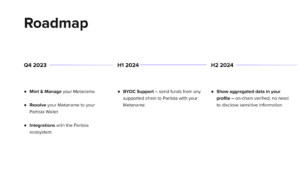
MetaNames aims not just to provide a base and core chain infrastructure but to fully leverage Partisia Blockchain’s innovative technology to improve the current NS industry.
Stay tuned for more, and keep up to date with us by following our Twitter!
Most may not know, but generating random numbers is hard. It is quite surprising because many people will think, “well, I can just come up with a random number off the top of my head!” However, randomly coming up with a number in your head, as well as other solutions to generate random numbers has fundamental flaws. And this is a big problem. Generating a fair unbiased random number is critical. In fact, random number generators are used everywhere.
The first place many would think of random numbers being useful is in games of chance. But would you be surprised if you knew that reading this article required the use of a random number generator? The website hosting this article is protected by a cryptographic key, which relies on generating a random set of values to be used for the encryption key.
Generating numbers at random is difficult. At a high level, there are two main issues with generating random numbers: predictability and bias/corruption issues.

The predictability issue for RNG can be seen in both human- and machine-generated random numbers. For example, there is a famous problem called Benford’s Law that states any random number that someone thinks about has a 30% chance of starting with the number 1. When you want to have a chance of a number being generated to be equal in percentage, then this becomes a problem. If you use a computer program to generate random numbers, you are using a structured code. This means, after multiple iterations, someone can reverse engineer the numbers to find the pattern and predict what the next number could be, especially if the code being used is weak.
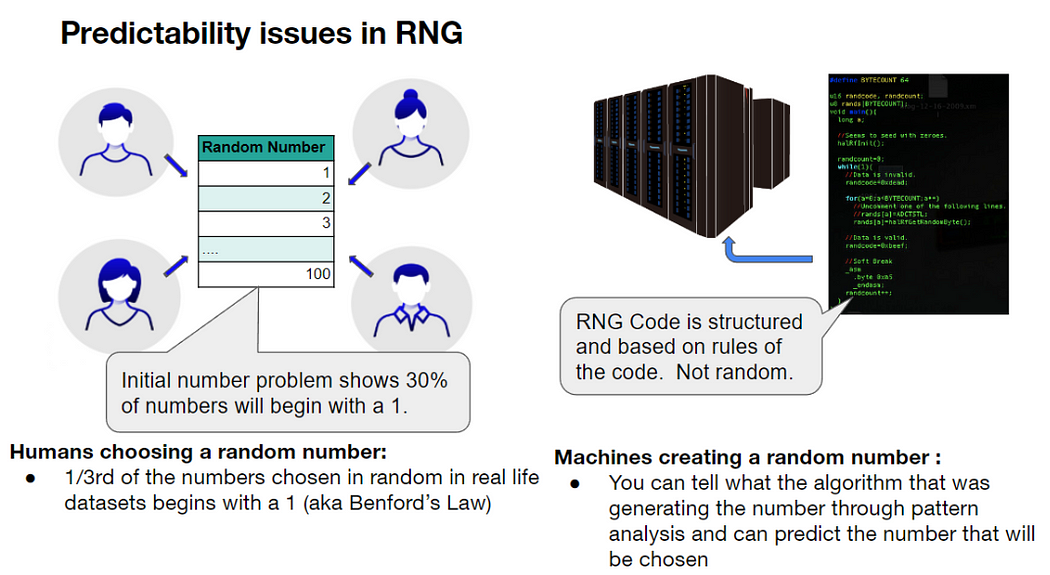
From a bias and corruption perspective, the current systems can also be gamed to give favor to someone. For instance, if a set group of people decide they will choose random numbers and run through some function to compute a random number, one person may withhold showing their number until they see what the other people have chosen. Then, once he knows the numbers of the other participants, he can choose a number that would compute the random number to his favor. From a machine generated random numbers, since most systems have a central system that is generating the numbers, anyone who has control of that system could also manipulate the numbers being generated to their favor.

So how can we create a system where it is both unpredictable and bias free? Through MPC and Partisia Blockchain, we can solve both problems. Through smart contracts, players in the system generate a random number. This random number is then privatized and sent into the PBC blockchain. A zero-knowledge computation is done, in a similar way as done through secret sharing and through a computation, a random number is revealed.

Through combining multiple players and secret sharing, developers can create a system to come up with a random number that is free from bias, incorruptible and impossible to predict. And Partisia Blockchain’s smart contract language will afford developers to customize this solution to their specific requirements.
By creating a programming language that allows for developers to use MPC in a generic way, Partisia Blockchain Foundation has made the creation of applications that can harness the power of MPC for different use cases a possibility. Partisia has been at the forefront of providing private MPC solutions since 2008. And by layering this technology on top of an interoperable and scalable blockchain, Partisia Blockchain is now paving the way for anyone to create solutions that can balance privacy and transparency to build trust.
To learn more about different use cases or partner with us for solutions, please visit partisiablockchain.com, check out our Medium articles, development documentations or email us at build@partisiablockchain.com.
Trust is the basis for any relationship. Whether it is between you and your friends, or between one company working with another, even with governments sharing information with each other. Without trust, society cannot exist. Every type of a relationship requires some type of trust that is built through time.
But what is trust? And how does one go about establishing it with another entity? Trust is earned through a give-and-take between parties and demonstrated pattern of reliability. It is also relative, as everyone has a different level of risk appetite. A balance that is relative to the amount of risk the person is willing to take against the amount of reliability the other party has demonstrated in the past.
So how does this balance take place?
Clearly, if no one is willing to share or demonstrate anything about themselves, trust cannot be established. There has to be some level of vulnerability to even begin the initial stages of establishing trust. But at the same time, complete and full transparency also does not help establish trust. And this is because almost all relationships start off mutually distrustful. Trust is something earned. If given to someone arbitrary, that person could use that trust against you.
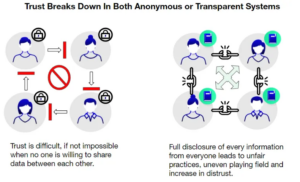
And in a way this balance of privacy and transparency to establish trust has been tipped in favor of one side to another throughout history. How many times have you or someone you know been burned by giving trust to someone who–knowingly or unknowingly–betrayed it? How many deals are broken between companies? How many government secrets have been compromised through leaks? Building trust is a gradual process, where one party shares something in hopes that the other party shares something of equal value.
But what if there was a way to share information without sharing information?
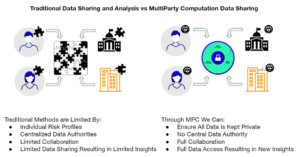
As we reviewed in other articles, multiparty computation allows for the computing of data even if the owner does not share the details around it. And in the example of sharing of data, this means any mutually distrustful parties can collectively allow the use of their data without sharing the details of data itself.
What does this mean in practice? At a high level, this means you can now reduce the weight of risk in the balance of establishing trust. Because you no longer have to expose your private data, the risk of that data being used against you is lowered. And this means you no longer require the same heavy weight for demonstrated reliability that you would need on the other side of the trust scale.
This is a game changer on many levels. Trust is the fundamental basis for any relationships between entities. With MPC, we now have the opportunity to change how this can be played.
In the example below, let’s say we have two financial companies that are competitors. They have a lot of secrets they would like to keep internal, but they do business with each other as a part of their overall practice. As a result of their business, there are many mutual clients. If there was a suspicious activity in one of their clients, having a single set of data they can analyze may not be enough. But what if both companies could share the use of their data together for forensic analysis without sharing the details of the data itself? This may lead to a far more comprehensive analysis.
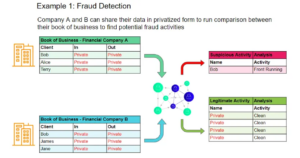
Another example is where multiple companies need to validate meeting of certain regulatory or compliance goals. But to compute the data, it requires exposing private information. Through MPC and Partisia Blockchain, a company will be able to validate meeting regulatory goals without exposing their data to the public.
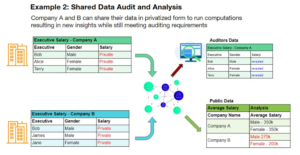
These are very simple examples of how companies can still work together without revealing their private data. And we have quite a variety of projects building on Partisia Blockchain that takes advantage of this new way of doing business.
CyberPeace Institute is working with Partisia Blockchain to help NGOs combat the issue of malware and ransomware by allowing NGOs to privately work with other parties who may be facing similar attacks. This allows NGOs to work together with others without reputation impact or exposing information that may create other vulnerabilities in their system.
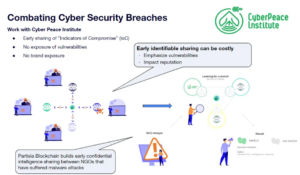
Monadi is working on helping companies comply with CSRD regulations that will impact over 50,000 companies in the EU. By 2025, companies will need to validate that they are meeting certain SDG goals, with the first goal being able to certify that there is no gender pay gap in their executives’ compensations. As the regulation matures, Monadi will be in a good position to help companies certify other SDG requirements without the need for the company to expose private data.
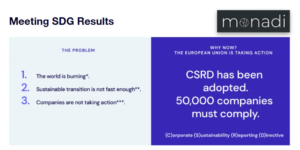
With a growing number of partners and integrators looking to solve the issue of trust, Partisia Blockchain is well positioned to help provide the solutions we need–whether it is to address the transparency in blockchains or to solve existing problems outside the blockchain space.
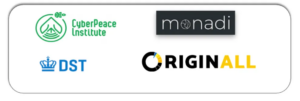
For additional insights on this use case, come and watch our Q&A session we did on this topic.
By creating a programming language that allows for developers to use MPC in a generic way, Partisia Blockchain Foundation has made the creation of applications that can harness the power of MPC for different use cases a possibility. Partisia has been at the forefront of providing private MPC solutions since 2008. And by layering this technology on top of an interoperable and scalable blockchain, Partisia Blockchain is now paving the way for anyone to create solutions that can balance privacy and transparency to build trust.
To learn more about different use cases or partner with us for solutions, please visit partisiablockchain.com, check out our Medium articles, development documentations or email us at build@partisiablockchain.com.
Ledgers are the primary ways settlements are recorded. The first double bookkeeping ledger system was recorded in use as far back as the 1300s. It is still the de-facto system used today to record transactions between entities.
Fast forward to 2008. Satoshi Nakamoto (pseudonym) was frustrated with the corruption due to the lack of transparency and centralized control of the traditional system. He proposed a transparent distributed ledger system that was immutable as a system of recording transactions. Thus Bitcoin was born.
But with all new systems, there is always room for improvements.
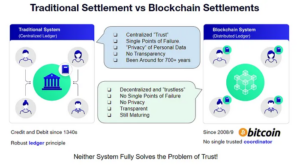
As discussed in our previous articles, full transparency does not solve the problem of building trust. In fact, privacy is a requirement in any trust relationship. For example, nobody would trust a credit card provider that revealed every purchase cardholders made just by someone having their credit card number. In a traditional blockchain space, every transaction is written in a public ledger. It would only require matching a wallet address to a name to see the full history of their transactions.
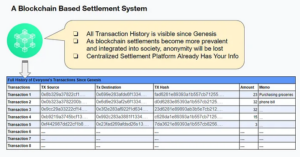
How can you have a blockchain that privatizes transactions and has enough flexibility to analyze and compute the data? Through integrating a proven technology into a scalable and interoperable blockchain.
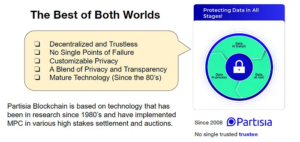
Developers can pick and choose which part of the data in the blockchain needs to be private and which can be public. All thanks to the Partisia Blockchain’s programmable MPC. A layer of governance can be enabled around the private data to allow for computation and access to select individuals. Those who access the data can also be audited transparently.
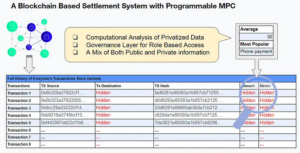
Now, even if someone has your credit card details, they will not be able to see your purchase history and your spending. If needed, a governance model can be created to ensure auditability and traceability to the system.
The importance is evident in our partnership with the International Committee of the Red Cross (ICRC). We partnered with the ICRC to build out a program for distributing aid through blockchain. One of their key requirements was privacy of the aid recipients. As they are a very unique organization, one of their key principles is in confidentiality and bilateral dialogue. The ICRC mainly operates in conflict zones and lack of privacy can mean life or death.
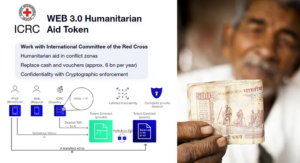
ICRC was able to solve their key challenge of privatizing the transactions of the stable tokens in the ecosystem thanks to Partisia Blockchain’s MPC. As shown above, the deposit of the funds from ICRC is kept private. As a result, transfers between the users are anonymous. To learn more, please watch our video of the overview of the solution here.
As blockchains become more prevalent, the need for privacy will continue to grow and take center stage. Various projects are already being built with private settlements in mind. We continue to speak with many organizations who prioritize the need for privacy in a blockchain solution.
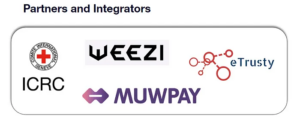
For additional insights on this use case, come and watch our Q&A session we did on this topic.
By creating a programming language that allows for developers to use MPC in a generic way, Partisia Blockchain Foundation has made the creation of applications that can harness the power of MPC for different use cases a possibility. Partisia has been at the forefront of providing private MPC solutions since 2008. And by layering this technology on top of an interoperable and scalable blockchain, Partisia Blockchain is now paving the way for anyone to create solutions that can balance privacy and transparency to build trust.
To learn more about different use cases or partner with us for solutions, please visit partisiablockchain.com, check out our Medium articles, development documentations or email me at bruce.ahn@partisiablockchain.com.
In a traditional asset trading platform, front running is defined as the illegal practice of placing a trade based on advanced non-public knowledge of an upcoming trade which can impact prices. As shown in the example below, a broker can take advantage of a situation when he or she gets a large order by one of their clients. Since they know this order will impact the price of the asset, they place their own personal order ahead of their client’s order. Then, they place the client order, raising the stock price. Once this is done they will sell their own shares to profit off their clients order.
Another term used often is insider trading, which is based on a very similar practice of using information only they have access to in order to gain an unfair advantage over others.
In the Web3 space, everything is transparent and, ironically, revealing too much information can also create these situations. An example of this is front running on a decentralized exchange (dex) that you may have already heard of. This type of a front running is possible through the combination of having total transparency in the blockchain along with how Ethereum (and many other blockchains) prioritize transactions in a node’s mempool.
In this particular example, an attacker (usually a bot) scans the mempool to see a particular scenario that they can take advantage of. Scanning the mempool, they look for an opportunity to insert in a bid at a lower price but higher gas than another large bid already in the mempool.
Once their bid completes, they wait for the larger order to go through, raising the price of the asset. Then they place a sell order at a higher price than the buy order he placed ahead of the larger order, and pockets the difference. All this is happening in a blink of an eye, making it impossible for any normal person to be able to recognize they are being taken advantage of.
But what if we could make the orders private? This prevents the attacker from being able to read the auction details in the mempool, and making the bot unable to identify a situation to take advantage of.
Through multiparty computation (MPC), details can be kept private while still computing the winner. In the situation of this dex, the results of the prices are not revealed until the bids are completed, ensuring that attackers cannot gain any advantageous information ahead of time.
The team in Partisia has already provided solutions to solve this issue in multiple scenarios. From governments to OTC trading platforms, they have been trusted to run high stakes auctions in different levels and through enabling this technology on a blockchain, we are giving everyone the power to solve the problem of ensuring integrity in the bidding process.
For additional insights on this use case, we recommend viewing our Q&A session on this topic.
By creating a programming language that allows for developers to use MPC in a generic way, Partisia Blockchain Foundation has made the creation of applications that can harness the power of MPC for different use cases a possibility. Partisia has been at the forefront of providing private MPC solutions since 2008. And by layering this technology on top of an interoperable and scalable blockchain, Partisia Blockchain is now paving the way for anyone to create solutions that can balance privacy and transparency to build trust.
To learn more about different use cases or partner with us for solutions, please visit partisiablockchain.com, check out our Medium articles, development documentations or email me at bruce.ahn@partisiablockchain.com
Your opinion matters. It matters so much that the global online data market estimate is to be over US$270 billion dollars, all focused around buying and selling of your data to the highest bidders. It is a very complex web of transactions that ferry your data from one place to another and many times, your data is used in ways you never realized could be used for. From Cambridge Analytics’ controversial use of data to TikTok’s alleged aggressive data harvesting, there is a large market for your information and how it is used is very unclear.
The current Web2 market for surveys is in the exchange of your data. This means your opinion is collected, filtered, analyzed, sold and bought. The data may be collected anonymously, or it may be tied to your identity. Either way, this data is collected and managed by a centralized system, which has control over the data they purchased. There is also the ever growing concern of bots and AI scripts that automate and duplicate fake data leading to data integrity issues.

One of the ways a decentralized blockchain can help change the landscape of the survey market is through dissolving the centralized control problem. Because the data can be made public, and with no single point of control of the data, you can be sure that the data can reside on-chain and has no central ownership or control. However, this can create problems with privacy. All data is now public and this creates two issues.
A unified public and private smart contract, like the one Partisia Blockchain supports, enables the best of both worlds and solves the two issues above, where you now have a decentralized blockchain that eliminates any controlling entity while still being able to privatize your data. Not only does this retain the data marketplace but redefines it in a way where the user now has control over the data.

The online survey industry is large and is continuously growing. And this is because surveys hold a lot of valuable data. As reviewed in our earlier article on privatized voting, we use multiparty computation (MPC) on the blockchain to hide your data on-chain, but still allow for computing of the data.

While the private voting use case reviewed a very simple computation on who the winner of an election was, Partisia Blockchain’s programming language allows full algebraic equations to be used to calculate any number of computations using the hidden data. This means not only being able to compute on a single category, but also combine results of the computation from multiple categories.

This change in privacy of your survey data creates a new change in how the data marketplace can be viewed. By allowing the survey participants ownership of their data, but still allowing for the computation of it, the marketplace of the data has now shifted from buying and selling of your data to buying and selling of the “use of your data”. You now still hold ownership of the data and you are now selling the use of your data while still keeping your data private. This paradigm shift creates new opportunities for a different marketplace where you are not just selling your data one time, but rather allow for the possibility of both updating of the data in real time as well as being rewarded each time your data is used. And through privatized authentication, the data quality improves as well leading to better accurate analysis.

For additional insights on this use case, we recommend viewing our Q&A session.
By creating a programming language that allows for developers to use MPC in a generic way, Partisia Blockchain has made the creation of applications that can harness the power of MPC for different use cases a possibility. Partisia has been at the forefront of providing private MPC solutions since 2008. And by layering this technology on top of an interoperable and scalable blockchain, Partisia Blockchain is now paving the way for anyone to create solutions that can balance privacy and transparency to build trust.
To learn more about different use cases or partner with us for solutions, please visit partisiablockchain.com, check out our Medium articles, development documentations or email us at build@partisiablockchain.com.